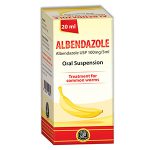
Ascariasis and Enterobiasis Pyrantel pamoate is used for the treatment of ascariasis (roundworm infection) caused by Ascaris lumbricoides and enterobiasis (pinworm infection) caused by Enterobius vermicularis. The drug may be used for self-medication of enterobiasis.









